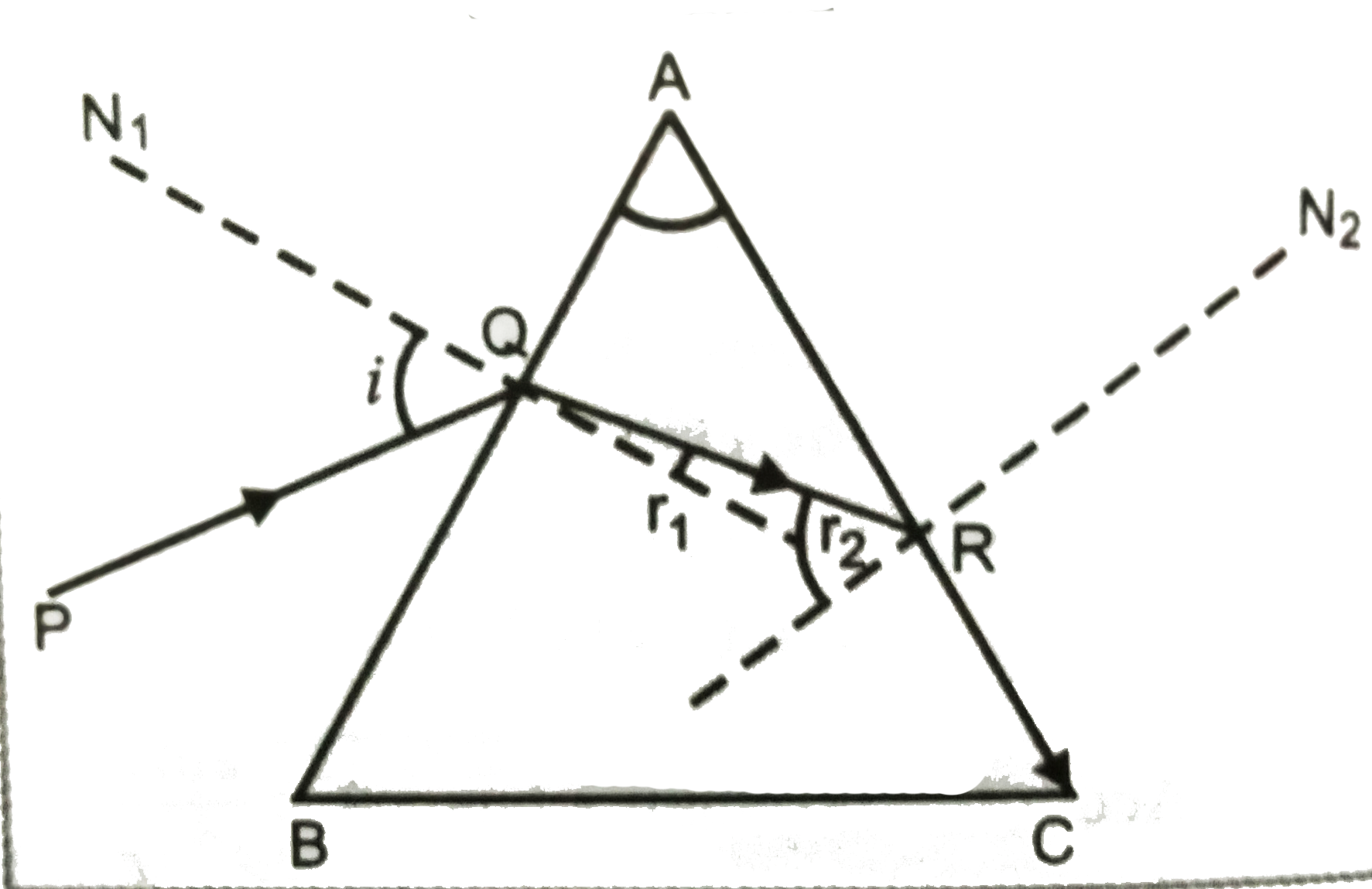A ray of light is falling on face AB of a tetrahedral of refractive index μ at angle of incidence i. The ray after getting internally reflected on face BC emerges from AD perpendicularly to the incident beam. Find the range of μ and i.
From figure b :i = i as 1 and 2 are perpendicular.Now for TIR total internal reflection to take place on face BC we should have
Related Solutions
A ray of light enters the face of a glass prism of refractive index at an angle of incidence . Find the value of such that no ray emerges from the face of the prism, given angle of prism is .
View SolutionA ray of light the face of a glass prism of refractive index at an angle of incidence . Find the value of such that no ray emerges from the face of the prism. Given angle of prism is .

View SolutionA light ray is incident on one refraction face of a prism, of refractive angle A, at an angle of incidence, I and emerges from the opposite face, normally. If refractive index of the material of the prism be what will be the value of the angle of incidence?
View SolutionA ray of light is incident at angle of incident ,I, on one face of a prism of angle A (assumed to be small) and emerges normally from the opposite face. If the refractive index of the prism is mu the angle of incidence i, is nearly equal to:
View SolutionA ray of light is incident at an angle of 60^(@) on a face of a prism with refracting angle 30^(@) . If the ray emerges from the other face and makes an angle of 30^(@) with the incident ray then, show that the emergent ray passes perpendicularly through the refracting surface. Determine the refractive index of the material of the prism.
View SolutionThe refracting angle of a prism is 60^(@) and the refractive index of its material is sqrt((7)/(3)). Find the minimum angle of incidence of a ray of light falling on one refracting face of the prism such that the emerging ray will graze the other refracting face.
View Solutionप्रकाश की एक किरण किसी प्रिज्म, जिसका प्रिज्म कोण A का मान सूक्ष्म है के एक फल पर i, कोण से आपतित होती है तथा उसके विपरीत फलक से उसके लम्बवत निर्गत होती है। यदि प्रिज्म का अपवर्तनांक है तब आपतन कोण i का मान लगभग बराबर होगा।
View SolutionA ray of light is incident at on one face of a prism of angle and the emergent ray makes with the incident ray. The refractive index of the prism is
View SolutionA ray of light is incident at on one face of a prism of angle and the emergent ray makes with the incident ray. The refractive index of the prism is
View SolutionA ray of light is incident at 60^(@) on one face of a prism of angle 30^(@) and the emergent ray makes 30^(@) with the incident ray. The refractive index of the prism is
View SolutionA ray of light is incident at 65^(@) on one face of a prism of angle of 30^(@) and the emergent ray makes 35^(@) with the incident ray. The refractive index of the prism is:
View SolutionA ray of light is incident at on one face of a prism of angle of and the emergent ray makes with the incident ray. The refractive index of the prism is:
View SolutionA ray EF of monochromatic light is incident on the refracting surface AB of a regular glass prism ( refractive index =1.5 ) at angle of incidence i=55^(@) (Figure). If it emerges the adjacent face AC, calculate the angle of emergence .e..
View SolutionA ray of light is incident at an angle of on the face of a prism having refracting angle The ray emerging out of the prism makes an angle with the incident ray. Show that the emergent ray is perpendicular to the face through which it emerges.
View SolutionA ray of light is incident at an angle of on the face of a prism having refracting angle The ray emerging out of the prism makes an angle with the incident ray. Show that the emergent ray is perpendicular to the face through which it emerges.
View SolutionA ray of light is incident at an angle of 60^@ on the face of a prism having refracting angle 30^@. The ray emerging out of the prism makes an angle 30^@ with the incident ray. Show that the emergent ray is perpendicular to the face through which it emerges.
View SolutionFind the angle of incidence of a ray of light on one face of a 60°.prism, if the ray is just totally reflected on meeting the opposite face (refractive index of glass = 1.5).
View SolutionAn isosceles prism has one of the refracting surfaces silvered. A ray of light is incident normally on the refracting face AB. After two reflections, the ray emerges from the base of the prism perpendicular to it. Find the angle of the prism.
View SolutionAn isosceles prism has one of the refracting surfaces silvered. A ray of light is incident normally on the refracting face AB. After two reflections, the ray emerges from the base of the prism perpendicular to it. Find the angle of the prism.
View SolutionA ray of light is incident at an angle of on one face of a prism . The emergent ray from the prism makes an angle of with the incident ray. The angle of emergence and refractive index of the material of the prism are-
View Solution